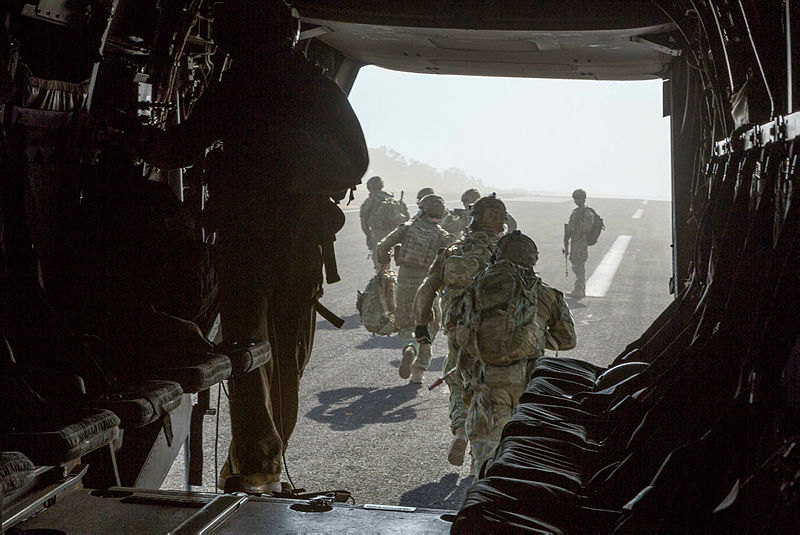It’s time to make good on defence commitments to northern Australia
Posted By John Coyne on May 24, 2019 @ 12:53

Prime Minister Scott Morrison has announced [1] that more Royal Australian Navy vessels will be built at the Henderson shipyard south of Perth, and the plan appears to have bipartisan support. The 2016 defence white paper and the associated integrated investment program have already committed to decades of continuous submarine and frigate building in South Australia.
Of course, there’s never been any doubt about the implementation of defence policies in southern Australia. In contrast, changes in defence investment patterns in Australia’s north seem to have flown under the political radar.
Both the government and the opposition have declared their support for defence and national security initiatives in northern Australia. However, they might be surprised to learn that the current level of commitment to the north isn’t what Labor set out in its 2009 and 2013 defence white papers or what the Coalition said in its 2016 white paper.
The 2015 white paper on developing northern Australia [2] pledged to strengthen the Department of Defence’s presence in the region. And the 2016 defence white paper [3] stated: ‘Investment in our national defence infrastructure—including the Army, Navy and Air Force bases in northern Australia, including in Townsville and Darwin, as well as the Air Force bases Tindal, Curtin, Scherger and Learmonth—will be a focus.’ It also predicted that Defence’s presence and investment in northern Australia would gradually increase.
However, there’s a growing body of evidence indicating that the gap is widening between strategic policy and Defence’s actual activities and presence in the north.
To begin with, Defence annual reports reveal that the number of personnel in the Northern Territory is already at an 11-year low [4].
In 2016, Defence sent a brigadier to Darwin to brief the local government and industry on its plans. The headline was that it was going to significantly increase expenditure on facilities and infrastructure to the tune of $7.7 billion over 10 years. In the almost three years since that visit, it’s estimated that Defence’s spend on facilities and infrastructure development and maintenance in the Northern Territory has fallen to under $1 billion.
In March 2018, Defence sent a colonel, to brief the same people, this time with a revised figure: $3.1 billion to be spent over six years. While Defence might be planning to spend another $3.6 billion right after the six-year commitment ends, that seems unlikely.
Defence intimated to those at this briefing that the US government would be investing in infrastructure development in support of the Marine Rotational Force—Darwin (MRF-D) initiative, which aspires to establish a marine air–ground taskforce of up to 2,500 personnel in Australia’s north.
While the MRF-D has been present since 2012, only one Northern Territory business has succeeded in obtaining a contract to supply the Americans. Local construction firms in the Northern Territory have reported challenges meeting the US government’s Miller Act bond requirements. The US requires Australian businesses to provide performance and payment bonds each equal to 100% of the original contract price—a level of bonding significantly higher than that used in the Australian market.
Then, in February this year, the US government’s plan to spend US$76 million on bulk fuel storage in Darwin was ‘earmarked’ as a cost saving to fund President Donald Trump’s border wall.
‘Earmarks’ don’t always become budget realities in the US, but it’s a reminder to Australia that we need to actively support the US Marines’ presence in the north, maximising the benefits that they get from engaging with the Australian Defence Force. A Marine Corps that values the training experience will protect the deployment and resist pressures to make savings to fund other political objectives.
Defence’s dwindling northern presence and opaque investment strategy come at a time of great strategic uncertainty.
The defence of Australia isn’t just about troop numbers and infrastructure development in the north. But it gets very hard to project force to defend Australia’s northern approaches on short notice if neither the personnel nor the infrastructure is there.
If that isn’t enough justification, the development of industry capacity in Australia’s strategically important north is critical for defence and national security.
The strategic defence and security outlook for the Indo-Pacific has deteriorated substantially since the MRF-D initiative was developed. And this change makes the presence of the Marine Corps in Darwin all the more important as an expression of America’s strategic commitment to the security of the region.
Australia has an integral role to play here by ensuring we fund our part of the cost of developing shared facilities in the north.
Both sides of politics should commit to strengthening an amphibious capability in the ADF that’s able to work with the marines and other partners in the region.
Now is the time for a renewed bipartisan commitment to the importance of a strong security presence in the north, including the US Marines presence.
Article printed from The Strategist: https://www.aspistrategist.org.au
URL to article: https://www.aspistrategist.org.au/its-time-to-make-good-on-defence-commitments-to-northern-australia/
URLs in this post:
[1] announced: https://www.theaustralian.com.au/nation/defence/federal-election-2019-pm-commits-to-build-three-naval-ships-in-wa/news-story/0d063119281804c25d4e496ccf2c26b7
[2] 2015 white paper on developing northern Australia: https://www.industry.gov.au/data-and-publications/our-north-our-future-white-paper-on-developing-northern-australia
[3] 2016 defence white paper: http://www.defence.gov.au/WhitePaper/
[4] at an 11-year low: https://www.aspistrategist.org.au/stopping-the-drift-to-the-south-defence-and-northern-australia/
Click here to print.